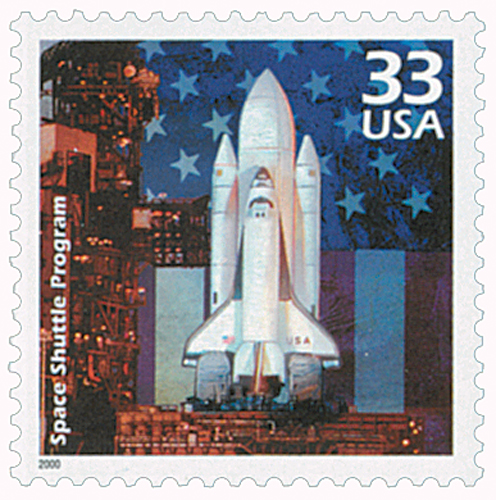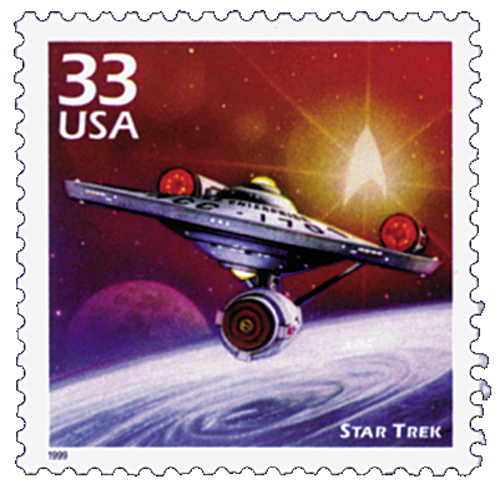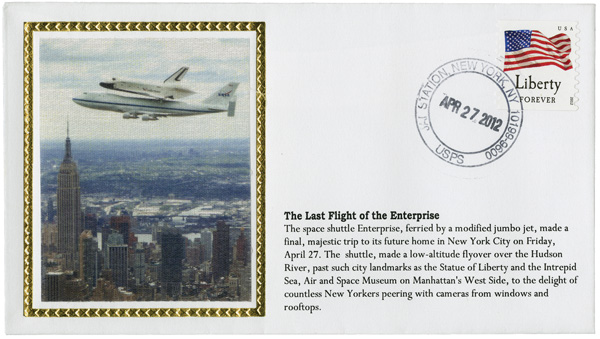
# SPC1528 - Shuttle Enterprise - Piggyback Ride to Intrepid
NASA Unveils Enterprise

On September 17, 1976, America’s first space shuttle, the Enterprise, made its debut public appearance.
In the 1960s and early 1970s, NASA and the Air Force researched different ways of flying winged vehicles back from space and landing them similar to an aircraft. From this research they built six different prototypes and flew 223 glide tests that would help them to develop the concept of the first space shuttle.

Plans for America’s first two shuttles were approved and contracts awarded on July 26, 1972. One shuttle would be a test ship built without engines or a heat shield, making it incapable of spaceflight, while the other, the Columbia, would be the first shuttle to make it into space.

Initially, the test ship, designated OV-101, was to be named Constitution, and presented to the public on Constitution Day, September 17, 1976. However, fans of the television show Star Trek launched a massive letter-writing campaign requesting that the shuttle be named after the starship from that show, the Enterprise. President Gerald Ford received hundreds of thousands of letters, and was also partial to the name, so he encouraged NASA to change it.
After the shuttle was completed, it was ready to be unveiled publicly. The rollout was still held on September 17, 1976, in Palmdale, California. However, because of the connection to Star Trek, series creator Gene Roddenberry and several cast members were invited to take part in the dedication ceremony. Click here for a photo from the ceremony.
The following year, the Enterprise began a series of flight tests that would prove invaluable to the future shuttle program. Most of these tests revolved around approach and landing. These tests proved that the shuttle could fly in the atmosphere and land like a plane even though it didn’t have power, similar to a glider. The Enterprise was also subjected to vertical ground vibration tests.

Initially, NASA planned to refit the Enterprise so it could be used in space, but they found it would be too costly. Instead, the Enterprise was retired and sent to the Smithsonian in Washington, D.C. It was later sent to New York as part of the Intrepid Sea, Air & Space Museum.
Click here for photos of the Enterprise.
NASA Unveils Enterprise

On September 17, 1976, America’s first space shuttle, the Enterprise, made its debut public appearance.
In the 1960s and early 1970s, NASA and the Air Force researched different ways of flying winged vehicles back from space and landing them similar to an aircraft. From this research they built six different prototypes and flew 223 glide tests that would help them to develop the concept of the first space shuttle.

Plans for America’s first two shuttles were approved and contracts awarded on July 26, 1972. One shuttle would be a test ship built without engines or a heat shield, making it incapable of spaceflight, while the other, the Columbia, would be the first shuttle to make it into space.

Initially, the test ship, designated OV-101, was to be named Constitution, and presented to the public on Constitution Day, September 17, 1976. However, fans of the television show Star Trek launched a massive letter-writing campaign requesting that the shuttle be named after the starship from that show, the Enterprise. President Gerald Ford received hundreds of thousands of letters, and was also partial to the name, so he encouraged NASA to change it.
After the shuttle was completed, it was ready to be unveiled publicly. The rollout was still held on September 17, 1976, in Palmdale, California. However, because of the connection to Star Trek, series creator Gene Roddenberry and several cast members were invited to take part in the dedication ceremony. Click here for a photo from the ceremony.
The following year, the Enterprise began a series of flight tests that would prove invaluable to the future shuttle program. Most of these tests revolved around approach and landing. These tests proved that the shuttle could fly in the atmosphere and land like a plane even though it didn’t have power, similar to a glider. The Enterprise was also subjected to vertical ground vibration tests.

Initially, NASA planned to refit the Enterprise so it could be used in space, but they found it would be too costly. Instead, the Enterprise was retired and sent to the Smithsonian in Washington, D.C. It was later sent to New York as part of the Intrepid Sea, Air & Space Museum.
Click here for photos of the Enterprise.











